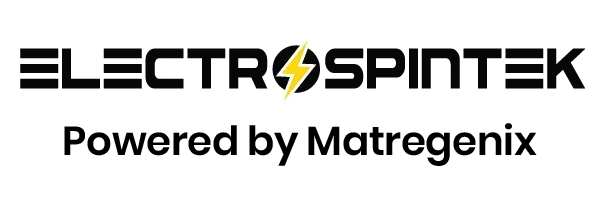Low voltage electrospinning is quietly transforming the landscape of nanofiber production. Once confined to large-scale industrial labs with high-voltage power supplies, this innovative technique has now become more accessible, safer, and portable. Whether you’re a materials scientist, a curious researcher, or a startup founder eyeing cutting-edge fabrication methods, low voltage electrospinning offers a practical entry point into the fascinating world of nanofibers.
At Electrospintek, we specialize in advancing electrospinning solutions tailored for simplicity, efficiency, and safety and low voltage systems are a core part of that mission.
What is Low Voltage Electrospinning?
Electrospinning is a method used to produce ultrafine fibers often on the nanoscale by applying an electrical charge to a polymer solution or melt. Traditional systems operate at high voltages (15–30kV), which, while effective, pose safety risks and limit. Where and how the machines can be used.
Low voltage electrospinning, on the other hand, reduces this barrier by operating in the range of 5–10kV, sometimes even lower. Despite the lower voltage, it still produces consistent, high-quality nanofibers, making it ideal for lab environments and small-scale applications.
Advantages of Low Voltage Electrospinning
1. Safer Laboratory Use
The biggest win? Safety. In laboratory electrospinning environments, reducing voltage means reduced electrical hazard. Researchers and students can now conduct experiments without the same level of risk, making it easier to integrate into academic settings and training facilities.
2. Energy-Efficient Operation
Operating at lower voltages naturally consumes less energy. That’s a plus for anyone seeking sustainable nanofiber production techniques. Especially in portable setups or field applications where energy sources may be limited.
3. Compact and Portable Design
A low voltage system is often synonymous with a portable electrospinning device. These machines are sleek, easy to move, and surprisingly efficient. Whether you’re working in a mobile lab or a small university space, these systems fit in seamlessly.
4. Perfect for Small-Scale Projects
For startups or research teams focusing on early-stage development, a small-scale electrospinning machine is the perfect fit. It lets you test material properties, optimize polymer blends, and scale ideas without investing in massive industrial machinery.
Applications: Where Low Voltage Electrospinning Shines
Low voltage electrospinning opens the door to various fields without the logistical nightmare of high-powered setups. Here are a few exciting use cases:
● Biomedical Research
From wound dressings to tissue scaffolds, the demand for nanofibers in medical applications is growing fast. Low voltage electrospinning makes it easier for R&D labs to prototype and experiment safely.
● Wearable Technology
Textile innovation often begins at the fiber level. Low voltage systems allow textile engineers to produce smart, breathable, and functional fabrics without needing a full industrial-scale setup.
● Environmental Filtration
Filtration media made from nanofibers are highly effective. Labs experimenting with air and water filters can rapidly test new ideas using compact electrospinning setups — without the cost or complexity of traditional systems.
● Educational Purposes
Universities and technical schools benefit from safe, hands-on exposure to electrospinning. Students get to witness real-time electrospinning system setup, test polymers, and explore material behavior in a controlled, safe environment.
Setting Up a Low Voltage Electrospinning System
One of the best things about low voltage electrospinning is how accessible the setup process is. At Electrospintek, our machines are designed for ease of use, even for those new to nanofiber production.
Here’s what a basic setup typically includes:
- Syringe Pump: Controls the flow rate of the polymer solution.
- Voltage Source: Provides controlled, low-level electric charge.
- Collector Plate or Drum: Where nanofibers accumulate in a thin web.
- Enclosure: Ensures safe operation and environmental control.
Setting up takes just a few minutes, and adjustments to parameters like solution viscosity. Tip-to-collector distance, and voltage can be made quickly to optimize fiber morphology.
Why Choose Electrospintek?
We’re not just selling machines we’re building tools for discovery. Electrospintek’s low voltage electrospinning systems are:
- Modular: Easily upgradable as your research or production scales.
- Reliable: Designed with stability and repeatability in mind.
- User-Friendly: Touchscreen interfaces, guided setup, and built-in safety protocols.
Whether you’re creating biodegradable nanofibers or testing advanced composites, our systems offer the flexibility and safety you need.
Final Thoughts: Small Voltage, Big Possibilities
In the world of nanofiber production, low voltage electrospinning is a game-changer. It’s accessible, adaptable, and makes exploring this once-intimidating process more feasible than ever. Whether you’re in a lab, classroom, or small innovation hub, these compact devices bring high-tech fiber fabrication into reach.
At Electrospintek, we believe that big ideas often start small sometimes with just a whisper of voltage. Ready to dive into the future of material science? Let us help you get started with the perfect low voltage electrospinning system.
